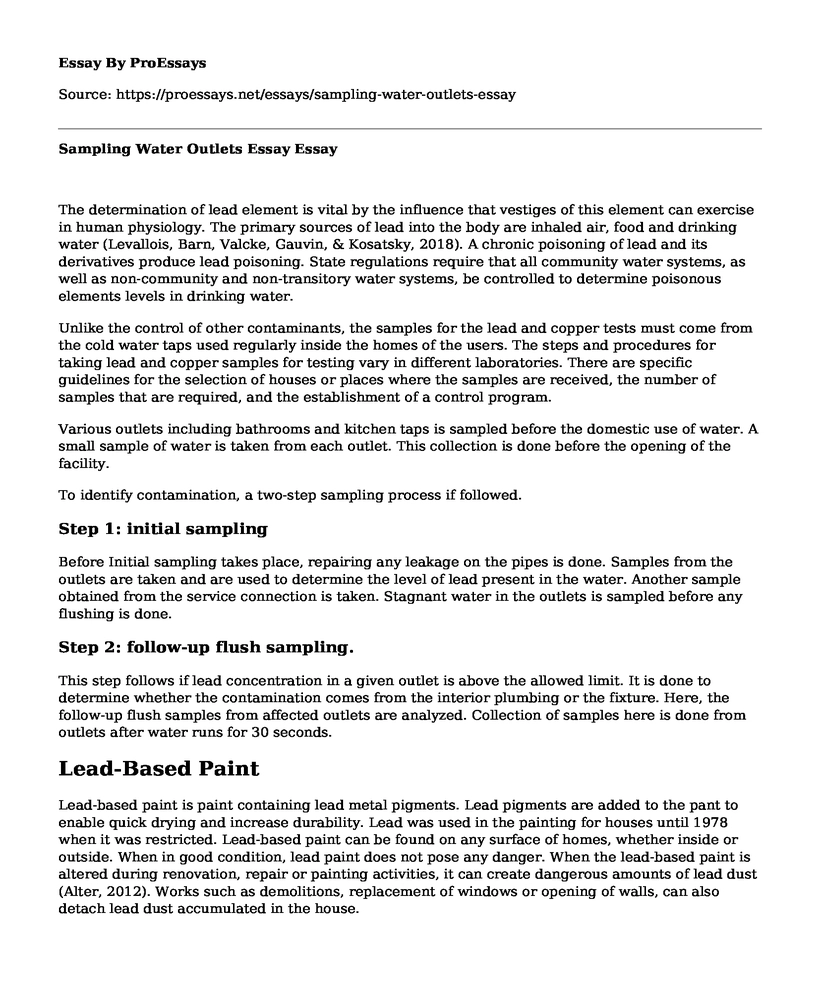The determination of lead element is vital by the influence that vestiges of this element can exercise in human physiology. The primary sources of lead into the body are inhaled air, food and drinking water (Levallois, Barn, Valcke, Gauvin, & Kosatsky, 2018). A chronic poisoning of lead and its derivatives produce lead poisoning. State regulations require that all community water systems, as well as non-community and non-transitory water systems, be controlled to determine poisonous elements levels in drinking water.
Unlike the control of other contaminants, the samples for the lead and copper tests must come from the cold water taps used regularly inside the homes of the users. The steps and procedures for taking lead and copper samples for testing vary in different laboratories. There are specific guidelines for the selection of houses or places where the samples are received, the number of samples that are required, and the establishment of a control program.
Various outlets including bathrooms and kitchen taps is sampled before the domestic use of water. A small sample of water is taken from each outlet. This collection is done before the opening of the facility.
To identify contamination, a two-step sampling process if followed.
Step 1: initial sampling
Before Initial sampling takes place, repairing any leakage on the pipes is done. Samples from the outlets are taken and are used to determine the level of lead present in the water. Another sample obtained from the service connection is taken. Stagnant water in the outlets is sampled before any flushing is done.
Step 2: follow-up flush sampling.
This step follows if lead concentration in a given outlet is above the allowed limit. It is done to determine whether the contamination comes from the interior plumbing or the fixture. Here, the follow-up flush samples from affected outlets are analyzed. Collection of samples here is done from outlets after water runs for 30 seconds.
Lead-Based Paint
Lead-based paint is paint containing lead metal pigments. Lead pigments are added to the pant to enable quick drying and increase durability. Lead was used in the painting for houses until 1978 when it was restricted. Lead-based paint can be found on any surface of homes, whether inside or outside. When in good condition, lead paint does not pose any danger. When the lead-based paint is altered during renovation, repair or painting activities, it can create dangerous amounts of lead dust (Alter, 2012). Works such as demolitions, replacement of windows or opening of walls, can also detach lead dust accumulated in the house.
Although direct contact with this metal affects adults, children suffer damage even in the presence of much more little. The effects on health are generally irreversible, and their impact can last throughout life (Brodkin, Copes, & Yassi, A. (2007). The human fetus is considered to be much vulnerable. A pregnant woman can pass the induced lead from her body to the fetus. Lead elements can also get to a child during breastfeeding. By keeping the paint in good condition and working safely with Lead when repairs or remodeling is in progress, the hazards can be minimized. The following measures can reduce the risks:
- Check to see that outdoor play areas, including the playgrounds of the neighborhood, are free of scales of paint.
- Wear gloves to collect paint flakes and discard them in a thick garbage bag, twisted at the top and sealed with cloth adhesive tape.
- Have children play on the grass or provide an area of lead-free sand.
- Have mats on the outside and inside of the entrances cleaned on a monthly basis.
- Check the peeling paint on a monthly basis or shelling. Also look for areas where surfaces painted are creating lead dust such as doors, windows, and cabinets.
- Repair areas small of damaged paint as soon as possible.
References
Levallois, P., Barn, P., Valcke, M., Gauvin, D., & Kosatsky, T. (2018). Public Health Consequences of Lead in Drinking Water. Current environmental health reports, 5(2), 255-262.
Alter, B. (2012). Environmental consulting fundamentals: investigation and remediation. CRC Press.
Brodkin, E., Copes, R., Mattman, A., Kennedy, J., Kling, R., & Yassi, A. (2007). Lead and mercury exposures: interpretation and action. Canadian Medical Association Journal, 176(1), 59-63.
Cite this page
Sampling Water Outlets Essay. (2022, Jul 25). Retrieved from https://proessays.net/essays/sampling-water-outlets-essay
If you are the original author of this essay and no longer wish to have it published on the ProEssays website, please click below to request its removal:
- Khoisan of South Africa
- The Profitability of Steam Boating on Western Rivers: 1850 Essay
- Environmental Issues Essay Example
- Essay Example on Global Warming: Unprecedented Climate Change in the 21st Century
- Article Analysis Essay on There May Be Flowing Water on Mars but Is There Intelligent Life on Earth?
- Water as a Reactant Paper Example
- Essay Example on Atmospheric States of the World: The North Atlantic Oscillation







